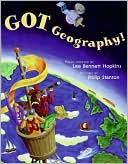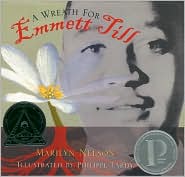There's no reason that poetry has to be relegated to a one-week unit, assuming that the teacher has time to get to it. And this is because there are poems and poetry collections that fit extremely well into existing school curricula.
 Studying geography? Try Got Geography!, edited by Lee Bennett Hopkins. Studying the planets? Don't miss Douglas Florians Comets, Stars, the Moon, and Mars. Studying explorers or pioneers? Try Trailblazers: Poems of Discovery by Bobbi Katz.
Studying geography? Try Got Geography!, edited by Lee Bennett Hopkins. Studying the planets? Don't miss Douglas Florians Comets, Stars, the Moon, and Mars. Studying explorers or pioneers? Try Trailblazers: Poems of Discovery by Bobbi Katz. Studying Civil Rights? Try A Wreath for Emmett Till by Marilyn Nelson, Miss Crandall's School for Young Ladies and Little Misses of Color by Elizabeth Alexander and Marilyn Nelson, Birmingham 1963 by Carole Boston Weatherford.
Studying Civil Rights? Try A Wreath for Emmett Till by Marilyn Nelson, Miss Crandall's School for Young Ladies and Little Misses of Color by Elizabeth Alexander and Marilyn Nelson, Birmingham 1963 by Carole Boston Weatherford. Studying animals and/or habitat? Try Valerie Worth's Animal Poems, illustrated by I.N.K. blogger Steve Jenkins, The Seldom Ever Shady Glades by Sue Van Wassenhove, If Not for the Cat by Jack Prelutsky, Vulture View by April Pulley Sayre (again illustrated by Steve Jenkins), Feathers by Eileen Spinelli or Mites to Mastodons by Maxine Kumin (or one of many more books on the topic).
 Interested in studying biographies? There's Twelve Rounds to Glory: The Story of Muhammad Ali by Charles R. Smith, Jr., Your Own, Sylvia: a verse portrait of Sylvia Plath by Stephanie Hemphill, The Poet Slave of Cuba: A Biography in Poems of Juan Francisco Manzano by Margarite Engle, or Jazz ABZ by Wynton Marsalis (biographies of jazz greats).
Interested in studying biographies? There's Twelve Rounds to Glory: The Story of Muhammad Ali by Charles R. Smith, Jr., Your Own, Sylvia: a verse portrait of Sylvia Plath by Stephanie Hemphill, The Poet Slave of Cuba: A Biography in Poems of Juan Francisco Manzano by Margarite Engle, or Jazz ABZ by Wynton Marsalis (biographies of jazz greats).The point is that for nearly any area of study, a poetry collection can be found that relates to it. And it should be found, because kids who have a hard time sitting still for prose lectures pay attention really well to poems. I suspect it's because of the use of lots of imagery and active verbs, the rhythm and, when used, rhyme, that grabs and holds the attention of kids who don't or can't always listen to prose.

Apparently some people have had problems leaving comments. I'm just testing, dear blogger.
ReplyDelete